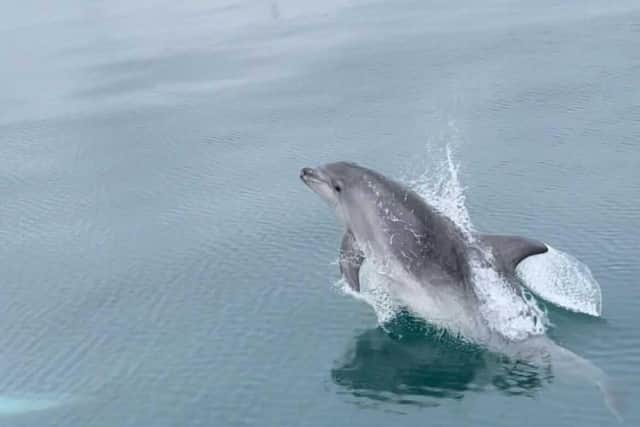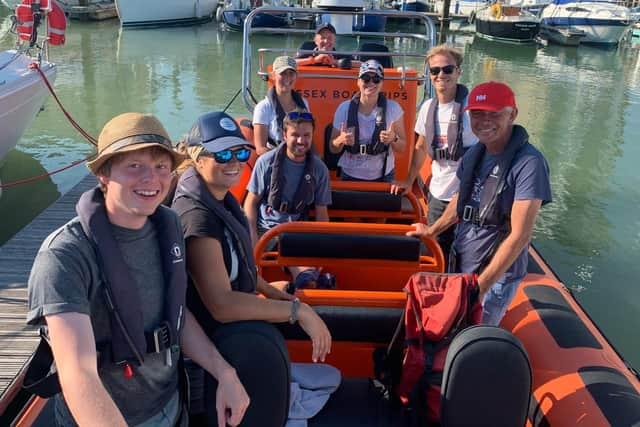Sussex Dolphin Project: What is the Sussex Dolphin Project and what you should do if you find a dolphin
and live on Freeview channel 276
Thea Taylor is head at Sussex Dolphin Project, which was set up in 2018 as an awareness and education project and became a research project in 2019.
She said: “Sussex Dolphin Project is committed to protecting local dolphin species through research, awareness and education programmes to deliver ecosystem-level restoration and rejuvenation.”
Advertisement
Hide AdAdvertisement
Hide AdThe most common spotted species found in Sussex is the Bottlenose Dolphin which has peak season between May to September. During the summer the project receives multiple sightings a day, especially if a pod is travelling close to the shore but they can disappear in a blink of an eye and be incredibly elusive.


Thea said: “Bottlenose Dolphins pass through Sussex all year, though in the winter months they are found further offshore so are less often sighted by members of the public.”
The second species is the harbour porpoise, which can be spotted all year-round but likes to avoid contact with people.Thea says that they believe they have a resident pod in East Sussex at Seven Sisters.
There are also seasonal visits from Common Dolphins in the summer months. These energetic cetaceans are usually seen in larger pods and will come closer to shore, unlike other summer visitors, White-Beaked Dolphins tend to stay further offshore.
Advertisement
Hide AdAdvertisement
Hide AdThea said: “Unfortunately, it’s very difficult to give precise numbers as the dolphins we see in Sussex are not resident here, they move along the channel coast throughout the year.


"Although we see Bottlenose Dolphins all year round they stay in the Sussex stretch of the channel for varying amounts of time, perhaps days or weeks before moving on. They tend to be seen further out to sea during the autumn and winter and closer to land during the spring and summer, sometimes as close as ten to 20 metres from the beach in August/September.”
Other resident colonies include grey seal, harbour seals often referred to as common seals. There have been reports of common seals as far north as Henfield.
The Grey Seal is the larger of the two species and spends most of its time further out to sea hunting for fish, but returns to land to rest where they can be seen hauled out on Sussex beaches.
Advertisement
Hide AdAdvertisement
Hide AdThea gives some advice about what you should do if you spot a marine mammal. The first thing you should do is take a video and photo and send it with location details, information on exactly what you saw including numbers and behaviour, how long you witnessed the mammals and what direction they were travelling in.
She added: “If you see dolphins from land, enjoy the spectacle and please let us know. If you see dolphins while on the water please be respectful and let the dolphins make the decision as to whether they want to come over and see you. “Dolphins are very inquisitive and will usually investigate any vessel in the water but to make sure the experience is safe for all parties please slow the speed of the boat to eight knots, maintain your course and turn off sonar and any other acoustic devices.
“If you come across seals on land, again be respectful. The vast majority of seals do not need our help. They just need to be left alone, but if you do spot a seal or cetacean in difficulty please make note of the location and contact the British Divers Marine Life Rescue (BDMLR) who can send out a team of trained experts to investigate further and support the animal if it needs it.”
If you find a dead dolphins on the beach Sussex Dolphin Project want to know as it forms an important part of their data.
Advertisement
Hide AdAdvertisement
Hide AdThe Sussex Dolphin Project is a volunteer organisation and relies on a team of committed and skilled individuals to run the project.
Thea said: “We are looking for a variety of skillsets from professionals that can offer skills to help the day-to-day running of the organisation, to people with a scientific research background to assist our citizen science programme, anyone with a background in marine biology or knowledge of marine life right through to those that wish to help us with our communications campaign, social media, fundraising, partnerships, beach cleans, boat trips, education projects and everything in between.”
The project aims to build awareness to help the local the community to better understand the marine mammals found in this stretch of the English Channel.
She said: “People won’t protect what they don’t value, and can’t value something that they don’t know about or understand. Awareness is driven in a variety of ways, including our boat trips, events and communications activities.”
Advertisement
Hide AdAdvertisement
Hide AdThere is also an education programme targets a range of audiences from school-age children to adults.
They also partner with Shoreham Port to deliver a conservation corridor project, which incorporates both terrestrial and marine rejuvenation and regeneration.
It also works with the South Coast Bottlenose Dolphin Consortium to share data on dolphins across the English channel coastline.
For more information, visit sussexdolphinproject.org/